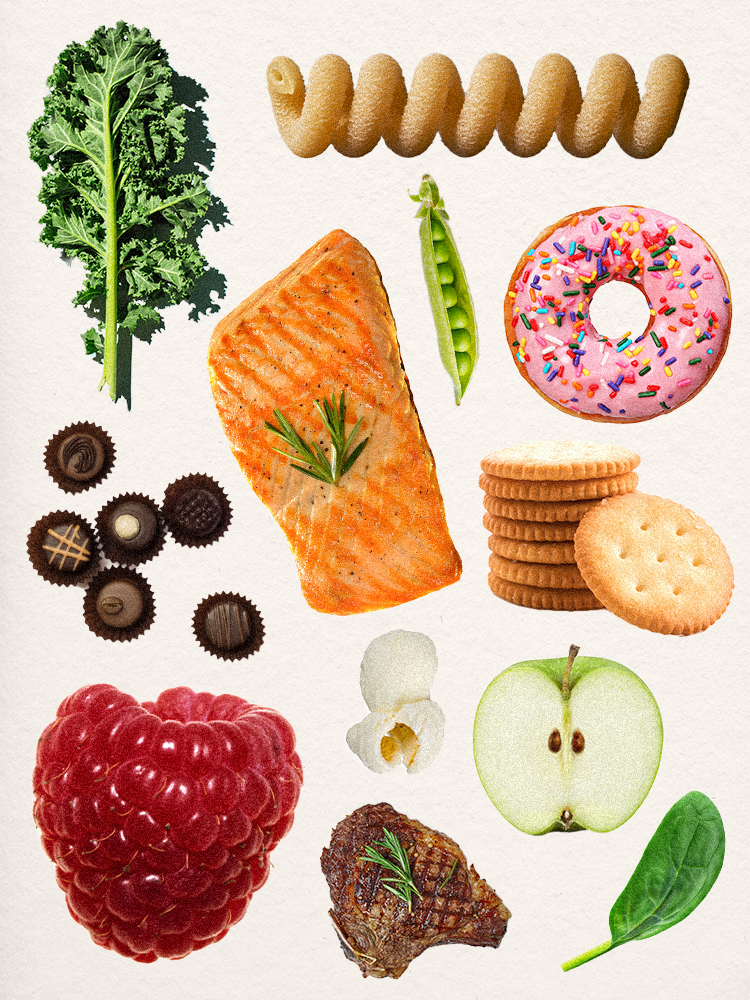What Is the Satiety Index, Anyway?
Medications like Ozempic make you feel fuller faster, but some foods already do that naturally, according to experts.

Eating disorders run in my family. Recently, a cousin died of one. It wasn’t just how much he ate but what: cola, chips, and candy round the clock. He basically snacked himself to death on a diet that led to heart disease, diabetes, and other complications. One reason he might have made unhealthy food choices is counterintuitive: He couldn’t stay full. “Food that is mainly carbohydrates or high in sugar is palatable. It goes down easily. It’s lower in volume, or water content, so you can eat a lot before your stomach expands,” explains Cara Harbstreet, a dietitian and the founder of Street Smart Nutrition. “But it doesn’t carry the fiber or other things that contribute to fullness and slow down eating.”
You know that stuffed feeling after polishing off a steak or a bowl of pea soup? Experts call it satiety. In 1995, Australian nutritionists devised a satiety index to track which foods made us feel fullest. Feeding subjects different foods and monitoring their hunger afterward, the researchers found foods with the lowest satiety were carb-and-sugar bombs. These are delicious, but their dopamine rewards amount to empty calories.
Foods with high satiety—those that keep you fullest the longest—are “high-thermic,” says food scientist Dr. Taylor C. Wallace, meaning that “muscles in the stomach and intestines take a lot of energy to break them down.” Chief among high-thermic foods is protein. “The body spends almost 30 percent of the calories it takes in from a protein trying to digest it.”
After protein on the high-thermic scale, there’s fat, which slows the body’s absorption of carbohydrates. Anyone who loves toast slathered in butter knows how fat carries flavor, which begets satiety and satisfaction. Then comes fiber—the roughage that makes whole grains, fruit, vegetables, and legumes harder (in a good way) to digest. High-fiber foods often contain lots of water, which further fills your belly.
That’s the gist of satiety: There are foods that take their time in your gut, and foods that don’t. “Generally, whole foods make you feel full longer than processed ones,” says dietitian nutritionist Kylene Bogden, a dietitian and functional sports nutrition expert who works with professional athletes.
But every expert I spoke with cautioned against using the satiety index as a diet plan. Diets, they say, don’t work. “Clinical studies show minimal, if any, effect,” Wallace notes. And the satiety index has only been used in a limited way in labs; it hasn’t been applied to a broad study of actual, everyday behavior, where its efficacy can really be tested.
Still, the concept of satiety is useful. “If you eat a doughnut, and your brain’s happy, you can understand why your stomach still wants a meal. If you eat fish and vegetables, and your body is happy, you know why your brain still wants the doughnut,” says Ariane Resnick, a special-diet chef and nutritionist whose clients have included Gwyneth Paltrow and P!nk.
Makes sense to me. In a world where celebrities are clamoring for weight-loss short-cuts like taking Ozempic and other diabetes drugs to suppress their appetites, and where others, like my cousin, refuse to take care of their diabetes and go for broke on unhealthful foods, paying attention to fullness seems like a sober and balanced approach to eating. The pros I spoke with have pointers for thinking about the satiety index.
Don’t mistake satiety for healthfulness. “You could eat a Wendy’s triple cheeseburger without the bun, and that’s high satiety, but it’s not healthy,” says Wallace. “You’ll see weight loss, but did you raise your bad cholesterol or give yourself hypertension?” Satiety can, however, help avoid the pitfalls of calorie counting. “You could starve yourself slamming low-cal Ritz Cracker packs that spike your blood sugar level. Then you’re hungry, can’t lose weight, and have no energy,” says Bogden. “Foods that are slower to digest keep blood sugar more stable.”
Go for satisfaction. Resnick isn’t a fan of steamed vegetables. “Roasted under a chicken or stir fried, vegetables are more appealing,” she says. If you agree with her, then you’re more inclined to eat your veggies with some fat on them. As it turns out, some vitamins are fat soluble; your body can’t access them unless the veggies are glistening in chicken drippings. “So think about what gives you satisfaction as well as nutrition. We do better listening to our bodies than to ideology.”
Diversify your plate. Protein, fat, and fiber: Satiety requires all three. “If one is missing, that leads to hunger,” Harbstreet explains. “You end up dissatisfied and might rummage around for something else to munch on.” That means combining colors, textures, and flavors at every meal as much as possible.
Resist dogma. “You’ll probably need more than fish and vegetables because, typically, those foods don’t give you the most joy and satisfaction, as they’re not full of sugar, salt, or fat, which are emotional triggers,” says Resnick. “So add a carbohydrate if you like.” If refined carbs (like white bread or pasta) make you happy, start there, then give less-refined carbs (like brown rice and pulses) a try.
Be proactive. Fully eliminating low-satiety foods is impossible. We aren’t robots, after all. Rather than abstinence, Harbstreet recommends a measured, mindful approach: “If you’re going to a birthday party, be strategic. Have a balanced meal beforehand, then go ahead and eat some cake.” It’s not about hard rights and wrongs. Make your choices on a “cake-by-cake” basis.
Write your own story. Get to know yourself through your eating. “Start with what you normally eat and keep a journal of how you’re feeling, and how full you are, 30 minutes, one hour, and two hours from eating,” suggests Bogden. Did your energy dip? Do you want to eat more? “Then gravitate to higher satiety foods, and journal again.” If journaling is dredging up bad feelings, go see a professional who can help you use satiety and other tools in a way that works for your mind and body. “None are the be-all, end-all,” says Resnick. “Every tool is something to consider to find what’s best for you.”
Keep Reading
Continue to Next Story










